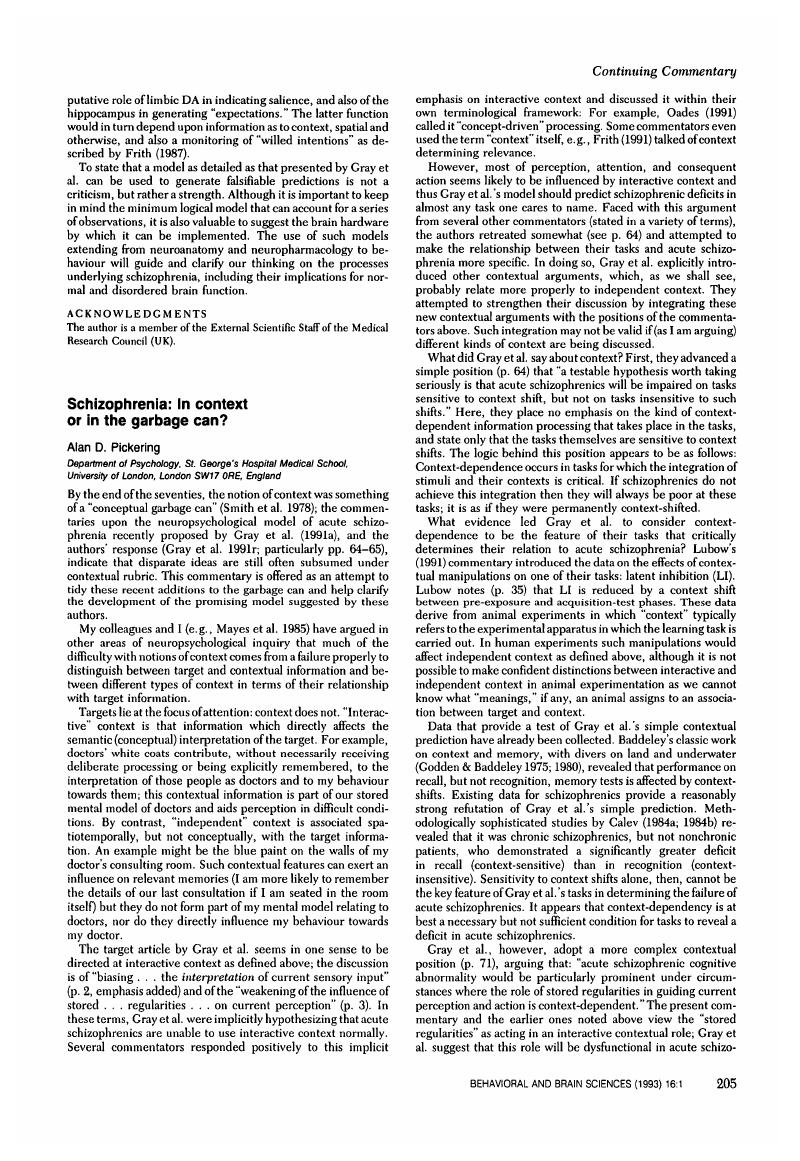Crossref Citations
This article has been cited by the following publications. This list is generated based on data provided by Crossref.
Hoffman, Ralph E.
and
McGlashan, Thomas H.
2003.
NMDA-receptor hypofunction versus excessive synaptic elimination as models of schizophrenia.
Behavioral and Brain Sciences,
Vol. 26,
Issue. 1,
p.
92.
Barch, Deanna M.
and
Braver, Todd S.
2003.
Where the rubber meets the road: The importance of implementation.
Behavioral and Brain Sciences,
Vol. 26,
Issue. 1,
p.
83.
Sass, Louis A.
and
Uhlhaas, Peter J.
2003.
Phenomenology, context, and self-experience in schizophrenia.
Behavioral and Brain Sciences,
Vol. 26,
Issue. 1,
p.
104.
Park, Sohee
Lee, Junghee
Folley, Bradley
and
Kim, Jejoong
2003.
Schizophrenia: Putting context in context.
Behavioral and Brain Sciences,
Vol. 26,
Issue. 1,
p.
98.
Raffone, Antonino
Murre, Jaap M. J.
and
Wolters, Gezinus
2003.
NMDA synapses can bias competition between object representations and mediate attentional selection.
Behavioral and Brain Sciences,
Vol. 26,
Issue. 1,
p.
100.
Strelets, Valeria
2003.
Cortical connectivity in high-frequency beta-rhythm in schizophrenics with positive and negative symptoms.
Behavioral and Brain Sciences,
Vol. 26,
Issue. 1,
p.
105.
Alpert, Murray
and
Angrist, Burt
2003.
The ketamine model for schizophrenia.
Behavioral and Brain Sciences,
Vol. 26,
Issue. 1,
p.
82.
Leiser, David
and
Bonshtein, Udi
2003.
Theory of mind in schizophrenia: Damaged module or deficit in cognitive coordination?.
Behavioral and Brain Sciences,
Vol. 26,
Issue. 1,
p.
95.
Titone, Debra
and
Debruille, J. Bruno
2003.
Guarding against over-inclusive notions of “context”: Psycholinguistic and electrophysiological studies of specific context functions in schizophrenia.
Behavioral and Brain Sciences,
Vol. 26,
Issue. 1,
p.
108.
Pflieger, Mark E.
2003.
Inferring contextual field interactions from scalp EEG.
Behavioral and Brain Sciences,
Vol. 26,
Issue. 1,
p.
99.
Hemsley, David R.
2003.
Schizophrenic cognition: Taken out of context?.
Behavioral and Brain Sciences,
Vol. 26,
Issue. 1,
p.
91.
Chen, Yue
2003.
Spatial integration in perception and cognition: An empirical approach to the pathophysiology of schizophrenia.
Behavioral and Brain Sciences,
Vol. 26,
Issue. 1,
p.
86.
Barendregt, Hendrik Pieter
2003.
A wide-spectrum coordination model of schizophrenia.
Behavioral and Brain Sciences,
Vol. 26,
Issue. 1,
p.
84.
Javitt, Daniel C.
2003.
Peeling the onion: NMDA dysfunction as a unifying model in schizophrenia.
Behavioral and Brain Sciences,
Vol. 26,
Issue. 1,
p.
93.
Talamini, L. M.
Meeter, M.
and
Murre, J. M. J.
2003.
Combating fuzziness with computational modeling.
Behavioral and Brain Sciences,
Vol. 26,
Issue. 1,
p.
107.
Roelfsema, Pieter R.
and
Supèr, Hans
2003.
Why do schizophrenic patients hallucinate?.
Behavioral and Brain Sciences,
Vol. 26,
Issue. 1,
p.
101.
Gooding, Diane C.
and
Braun, Jacqueline G.
2003.
Cognitive coordination deficits: A necessary but not sufficient factor in the development of schizophrenia.
Behavioral and Brain Sciences,
Vol. 26,
Issue. 1,
p.
89.
Condray, Ruth
and
Steinhauer, Stuart R.
2003.
Mechanisms of disrupted language comprehension in schizophrenia.
Behavioral and Brain Sciences,
Vol. 26,
Issue. 1,
p.
87.
Bressler, Steven L.
2003.
Context rules.
Behavioral and Brain Sciences,
Vol. 26,
Issue. 1,
p.
85.
Williams, Leanne M.
Lee, Kwang-Hyuk
Haig, Albert
and
Gordon, Evian
2003.
High-frequency synchronisation in schizophrenia: Too much or too little?.
Behavioral and Brain Sciences,
Vol. 26,
Issue. 1,
p.
109.



